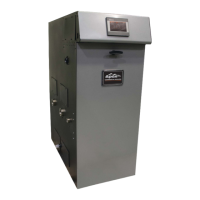100
106308-05 - 3/23
APEX Installation, Operating, & Service Instructions
14. Tune
Select to access the following parameters.
Select
to access the following parameters.
Parameter and Description Factory Setting Range / Choices
Response Speed
Adjusts Central Heat temperature control Proportion Integral Derivative (PID)
values. A higher value causes a larger firing rate change per degree of requested
temperature change. If set too high, firing rate overshoots required value,
temperature exceeds Difference Above, and boiler cycles unnecessarily. A lower
value causes a smaller firing rate change per degree of requested temperature
change. If set too low, firing rate response will be sluggish and temperature will
wander away from setpoint. Refer to Table 10-20 for PID values used by these
selections.
3 1 to 5
Proportional Rate
Proportional gain value for Central Heat temperature control. A higher value yields
tighter, more active, PID control. Proportional Rate is the primary PID modulation rate
tuning adjustment and provides the immediate modulation rate response. Select
value based on desired initial response. If set too high, burner modulation rate can
oscillate.
26
0 to 400
Integral Rate
Integral gain value for Central Heat temperature control. A higher value yields faster
ramp rate. Integral is a secondary PID modulation rate tuning adjustment that ramps
the output over time (typically minutes). Based on the selected Local PID P, select
the corresponding (from above table) Integral value. Repeats per minute between
0.5 and 2.0 are typical. If set too high, burner modulation rate can oscillate.
9 0 to 400
10 Operation (continued)

